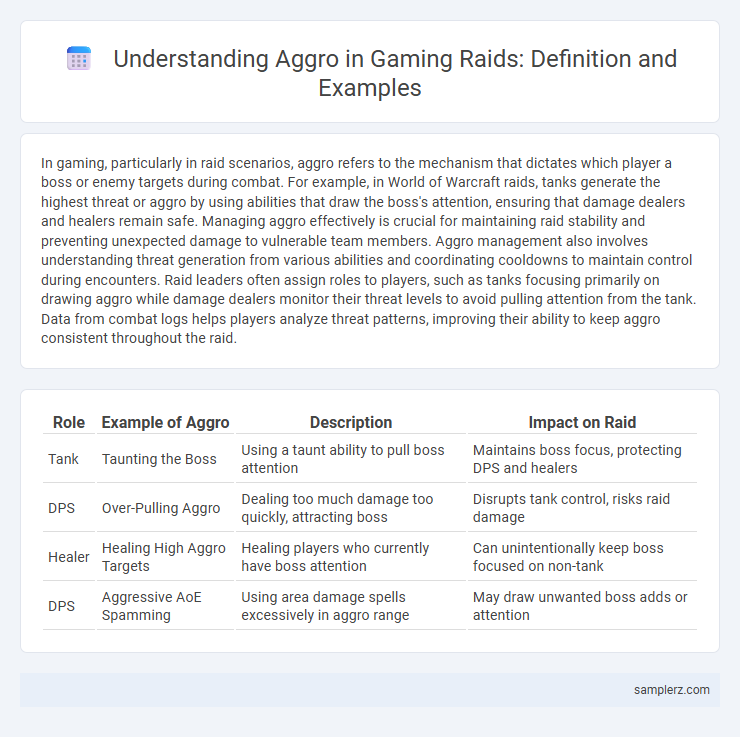In gaming, particularly in raid scenarios, aggro refers to the mechanism that dictates which player a boss or enemy targets during combat. For example, in World of Warcraft raids, tanks generate the highest threat or aggro by using abilities that draw the boss's attention, ensuring that damage dealers and healers remain safe. Managing aggro effectively is crucial for maintaining raid stability and preventing unexpected damage to vulnerable team members. Aggro management also involves understanding threat generation from various abilities and coordinating cooldowns to maintain control during encounters. Raid leaders often assign roles to players, such as tanks focusing primarily on drawing aggro while damage dealers monitor their threat levels to avoid pulling attention from the tank. Data from combat logs helps players analyze threat patterns, improving their ability to keep aggro consistent throughout the raid.
Table of Comparison
| Role | Example of Aggro | Description | Impact on Raid |
|---|---|---|---|
| Tank | Taunting the Boss | Using a taunt ability to pull boss attention | Maintains boss focus, protecting DPS and healers |
| DPS | Over-Pulling Aggro | Dealing too much damage too quickly, attracting boss | Disrupts tank control, risks raid damage |
| Healer | Healing High Aggro Targets | Healing players who currently have boss attention | Can unintentionally keep boss focused on non-tank |
| DPS | Aggressive AoE Spamming | Using area damage spells excessively in aggro range | May draw unwanted boss adds or attention |
Understanding Aggro Mechanics in Raid Encounters
In raid encounters, aggro refers to the mechanic where enemies prioritize attacking players based on threat levels generated by damage, healing, or specific abilities. Tanks typically maintain the highest aggro by using taunts and high-threat abilities to control enemy focus, ensuring damage dealers and healers remain safe. Understanding aggro mechanics is crucial for coordinated raid strategies, preventing unnecessary deaths and maximizing overall team performance.
Classic Examples of Raid Aggro Management
Raid aggro management is crucial in MMORPGs like World of Warcraft, where tanks maintain enemy attention by using abilities such as Taunt and Thunder Clap to control threat. Classic examples include the Molten Core raid, where tanks use precise threat generation to prevent DPS players from pulling aggro on powerful bosses like Ragnaros. Effective aggro control ensures survivability and raid success by minimizing damage to healers and damage dealers.
Main Tank vs. Off-Tank: Roles in Aggro Control
The Main Tank in a raid holds primary aggro, maintaining enemy focus through high-threat abilities and positioning to protect the team. The Off-Tank manages secondary targets, quickly acquiring threat to prevent adds from overwhelming healers and damage dealers. Effective aggro control between Main and Off-Tank ensures raid stability, minimizing damage taken and maximizing encounter success.
DPS Threat Generation and Aggro Swaps
In raid scenarios, DPS threat generation drives tank aggro management, where high damage output often causes unintended threat spikes. Efficient aggro swaps require clear communication and precise timing to prevent raid wipe risks, as tanks must quickly regain enemy focus from DPS players. Understanding individual threat levels and cooldown usage optimizes threat control, maintaining stable raid encounters.
Healer Aggro: How Support Roles Draw Threat
Healer aggro occurs when support roles inadvertently generate threat by healing high-damage targets or multiple players simultaneously, drawing enemy focus away from tanks. In raids, spells with high threat modifiers or overhealing can increase aggro, forcing healers to manage threat carefully through threat-reducing abilities or situational healing. Effective healer aggro management is crucial for maintaining raid stability and preventing unnecessary damage to fragile support characters.
Aggro Dumps and Threat-Reducing Abilities in Raids
Aggro dumps and threat-reducing abilities play a crucial role in managing enemy targeting during raid encounters, ensuring tanks maintain control while DPS and healers minimize threat generation. Abilities like a warrior's Taunt, a rogue's Vanish, or mage's Invisibility help reset or reduce threat, allowing raid members to avoid drawing aggro and prevent raid wipes. Efficient use of threat modifiers and cooldowns significantly enhances raid survivability and stabilizes boss fight mechanics.
Raid Boss Mechanics: Unique Aggro Resets and Transfers
In raid encounters, aggro management becomes crucial when unique boss mechanics force aggro resets or transfers, such as the boss periodically switching target priority to healers or randomly taunting players. These mechanics challenge traditional tanking strategies by requiring rapid threat adjustment and coordinated group positioning to minimize damage spikes. Efficient handling of aggro shifts prevents raid wipes and maximizes damage uptime on the raid boss.
Communication Tools for Managing Raid Aggro
Effective communication tools like voice chat and real-time raid management software help coordinate tank positioning and cooldown usage to manage aggro in raids. Platforms such as Discord and TeamSpeak enable instant alerts about threat levels, allowing healers and DPS to adjust their actions promptly. Integrating tools like Warcraft Logs provides detailed analysis of aggro patterns, improving overall raid threat control strategies.
Consequences of Poor Aggro Management in Raids
Poor aggro management in raids often leads to bosses targeting healers or damage dealers instead of the tank, causing raid-wide chaos and increased damage taken by vulnerable players. This misdirected threat can prompt unexpected deaths, forcing raid members to expend costly resources such as cooldowns and potions to recover. Consistently losing aggro disrupts raid flow, lengthens fight duration, and undermines overall group performance and success.
Pro Tips for Maintaining Optimal Raid Aggro Control
Managing raid aggro effectively is crucial for minimizing damage taken by healers and DPS in endgame content such as Mythic+ dungeons and raids like Castle Nathria and Sanctum of Domination. Maintain optimal raid aggro control by utilizing taunt rotations strategically, monitoring threat meters like Omen Threat Meter, and communicating enemy focus shifts in real-time. Employ cooldown alignment on tanks and leverage class-specific threat reduction abilities to prevent boss retargeting and secure stable enemy focus throughout complex fight mechanics.

example of aggro in raid Infographic
 samplerz.com
samplerz.com